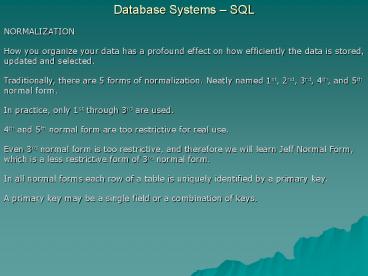Database Systems - PowerPoint PPT Presentation
1 / 9
Title:
Database Systems
Description:
Phillies. Mike Mussina. Mariano Rivera. Yankees. Pitcher2. Pitcher1. Team ... Phillies. Yankees. Yankees. Team. Flash. Mike. Mariano. PitcherFirstName ... – PowerPoint PPT presentation
Number of Views:49
Avg rating:3.0/5.0
Title: Database Systems
1
Database Systems SQL
NORMALIZATION How you organize your data has a
profound effect on how efficiently the data is
stored, updated and selected. Traditionally,
there are 5 forms of normalization. Neatly named
1st, 2nd, 3rd, 4th, and 5th normal form. In
practice, only 1st through 3rd are used. 4th and
5th normal form are too restrictive for real
use. Even 3rd normal form is too restrictive,
and therefore we will learn Jeff Normal Form,
which is a less restrictive form of 3rd normal
form. In all normal forms each row of a table is
uniquely identified by a primary key. A primary
key may be a single field or a combination of
keys.
2
Database Systems SQL
NORMALIZATION 1st Normal Form The goal of 1st
Normal Form is to break data into the smallest
units possible. Observe the following table
Therefore, any field that is non-atomic should be
broken into separate fields.
3
Database Systems SQL
NORMALIZATION 1st Normal Form Additionally,
data should not be stored with repetitious groups
of fields Observe the following table
When data is set up in this manner unused fields
are wasted. In addition, a set number of values
for the repeated field is hard coded into the
table instead of allowing an arbitrary number of
values. Instead you should create a record for
each value as shown in the following table
4
Database Systems SQL
NORMALIZATION 1st Normal Form However, now the
table does not have a simple primary key. Either
we can add a field to the table to identify the
pitcher or we can make the pitchers first and
last name part of the primary key.
5
Database Systems SQL
NORMALIZATION 2nd Normal Form Each progressive
normal form builds on the previous normal form.
Therefore 2nd normal form includes all of the
rules that apply to 1st normal form.
The above table is in 1st normal form and
contains a compound primary key of IDTeam,
IDPitcher. 2nd normal form states that in tables
with compound primary keys, each non-key field
should relate to a fact about all the keys in the
compound primary key. Otherwise, the data should
be reorganized into another table.
6
Database Systems SQL
NORMALIZATION 2nd Normal Form Observe the table
broken into three tables that are in 2nd normal
form.
7
Database Systems SQL
NORMALIZATION 3rd Normal Form 3rd normal form
is similar to 2nd normal form. The only
difference is it applies to non-compound primary
keys. Thus each non key field should be a fact
about the primary key. Otherwise it should be
placed in a separate table. Since the
combination of City, State and Zip are
repetitious, they do not belong in the table.
So City, State, and Zip should be in their own
table.
8
Database Systems SQL
NORMALIZATION 3rd Normal Form The correct 3rd
normal form is
9
Database Systems SQL
NORMALIZATION Jeff Normal Form Common sense. I
think examples like the zip code take
normalization too far. Personally, I would leave
it as it was in 2nd normal form. However, there
are times its ok to normalize. I just feel when
the data is coming in as a unit as city, state,
and zip are, that its ok to leave it as is. Also
zips, do some strange things. Not really a 1 to 1
relationship there.































